|
For thousands of years Aboriginal family groups camped along
the banks of the river.
The water was fresh and the forest filled with wildlife including kangaroo, emu,
possum, chuditch and quenda.
Europeans arrive

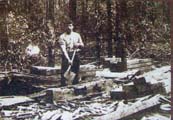
|
As European setlement spread throughout
WA in the 19th century, so did the demand for timber
to build houses, shops and bridges, and to supply the
rapidly
expanding rail network with sleepers.
Jarrah was richly prized and became the first commercial
export for the colony.
West Australian Jarrah was used to pave the streets
of London. Jarrah also proved
ideal for construction and building work and it was used for bridges, railways,
jetties, houses, furniture,
underground mines and ships.
Jarrah and black-butt timber was cut for the buildings
and formwork used during the construction of Wellington
Dam.
Wellington Mills, just a few kilometres from where the dam would one day be
built, was a timber settlement.
Steam trains carried timber and sleepers to the port of Bunbury.
|
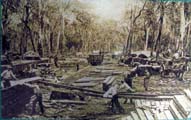
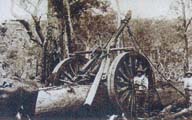 |
Timber was a major export for Western Australia
around the turn of the century.
However,
soon after improved technology
and a changing economic situation
led to the demise of the big mill, which
closed in 1919.
The Wellington Mills township and several smaller mills survived until 1950 when
they were destroyed by fire.
However it wasn't
long before more and more land was
taken up for farms and agriculture.
The new settlers named the Collie River Valley region "Wellington",
in honour of the Duke of Wellington.
The name was later adopted for the Wellington Dam and the once-thriving timber
settlement of Wellington Mills. |
An irrigation scheme
In the 1930s, during the Great Depression, there was a drive to fund public works
to provide jobs for thousands of people desperate for work.
A dam on the Collie River was proposed as a way to extend the South West irrigation
network and to encourage expansion in agriculture.
The Government, keen to push ahead with major public works
projects, wanted the work to go ahead as quickly as possible.
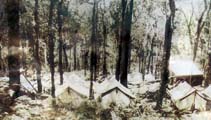 |
Construction
Two dozen surveyors and construction workers made their way along the banks of
the Collie River in 1931 searching for the best site to build a new dam.
After about three weeks they chose a site where the sides of the valley sloped
down to a large, flat granite rock that formed the river bed.
Construction of the Wellington Dam began in November,
1931.
More than a hundred workers, many with their wives
and children, made their way to live in the tiny
settlement of tents pitched in a forest clearing.
The location was isolated
deep within the forest and access was critical.
Penrith, small mill siding on the Brunswick to Collie railway, was upgraded to
handle equipment and supplies to the dam.
The men working hard to establish
a foundation on the river
bed before the high annual winter flows.During
the summer months the river flowed through two small channels.
By diverting the water through one channel the workers were able to dig
a foundation and build the concrete wall in stages across the river. |
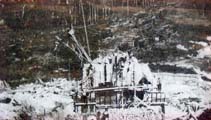 |
The men laboured on the dam wall, in the rock
quarry and at the sand pit nearby.
The base of the dam wall had to be excavated and formwork built to hold the concrete.
Other workers were busy clearing the valley where the water would gather, building
an access road to the site, and digging irrigation channels further downstream.
An area on the northern slope was chosen as the best site for the construction
plant.
A Babcock and Wilcox boiler, donated to the project by the Bunbury Town Council,
provided steam power for the main engine room, concrete mixer and conveyor belts.
A Sentinel type air compressor supplied air for three forges, jackhammers and
a shipping hammer.
Leads from the compressor were run more than
300 metres to the main works for
excavation on the foundations,
and 107 metres to the quarry for rock drilling.
The first rock crusher was always
breaking down and production was poor.
In June 1932, when the
crusher again broke down, it was decided to bring
in a Jacques
Jaw Crusher from Harvey, and output immediately doubled. |
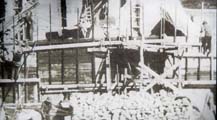 |
A conveyor belt carried the crushed stone
into bins where it was mixed with
sand cement.
The mix gravitated down chutes and into the concrete mixer.
The concrete was poured from a
chute suspended on an overhead
cable between two giant steel towers that where constructed on each side
of the valley.
Chutes slung between the
towers carried concrete to timber formwork that
shaped large sections
of the wall.
The concrete was poured in blocks
15 metres long by 7 metres wide and 2 metres
deep.
Every few days the pouring chute was moved along to as
a new section.
It was difficult and tedious operation for the men.
|
 |
The wall was made up of two straight, 76-metre "wings" that
stretched from each side of the valley, joined
by an 80-metre curved section in the middle.
By diverting the river through two natural channels, the wall was gradually extended
across the granite rock base that formed the river bed.
Most of the wall was built in this way with the final concrete sections poured
from a wooden trestle framework.
The dam wall was finished in just two years.
At the time the main dam wall was being built,
more construction work was going on downstream.
A road was cut through the bush to a site 11 kilometres away where a small
diversion dam was built to raise the water level to feed into the main irrigation
channels. The project was a major success,
and soon after the dam was finished in 1933, the demand for water was more
than could be supplied.
The amount of water available to irrigation was increased in 1944 when another
metre was onto the height of the main dam wall.
In 1955 work commenced to treble the storage capacity of the dam, by raising
the wall another 15 metres.
Completed in 1960, this increased storage provided enough drinking water, carried
by pipe, for the inland towns of the Great Southern.
The dam, as it is today, is 34 metres high and 366 metres long.
The dam stores about 186 million kilolitres of water when full. |
Water use
Over thousands of years climatic and geological changes have
shaped and determined the current land uses in the Collie
River Catchment.
Deposits of plant material formed the
coal seams mined at Collie, rainfall and temperature changes produced
tall Eucalypt forests that spawned a thriving timber industry,
and the rivers provided an abundance of water for human
and stock use.
The total Collie River Catchment covers about 4'000 square
kilometres and is fed by two main tributaries - one rising
near Darkan, east of Collie and another further south,
coming from hills near Boyup Brook.
These tributaries combine
near
Collie and eventually flow into the Leschenault Estuary,
near Bunbury.
The river flows have been boosted since 1903 with water
pumped from the coalmines near Collie.
However, a pattern
of lower
rainfall since the 1960s has reduced the amount of water
flowing into the Wellington Dam.
In its natural state the river water was fresh, providing
a breeding haven for marron and for the native catfish.
More recently, red fin perch have been introduced and
now flourish.
For many years the Wellington Dam was a source of drinking
water for inland towns in the Great Southern region.
A pipeline was built to Narrogin in 1956 and later extended to other towns.
WA's
second hydro-electric power station was built on the Collie River about 400
metres downstream from
the dam in 1956.
The 2'000 kilowatt station is still in use and can
produce enough power to supply 1'500 homes. The widespread clearing for farmland in the Collie River
Catchment over the past century caused salinity levels
in the water to rise.
In 1976, clearing controls were
introduced and in 1979 a re-afforestation program began
in an effort
to control salinity.
However, the salinity levels continued
to rise in the short term, to a point where the dam could
no longer be used as a source for drinking water.
To provide fresh water for Collie and the towns of the
Great Southern Region, a new dam was built on the Harris
River, about 12 kilometres north of Collie.
The new
dam was completed in 1990.
Careful management of the
Collie
River Catchment, including continued re-afforestation
work, is expected to bring down salt levels.
Within the forest there are around 100 bird, 27 mammal,
40 reptile and 13 frog species.
However, the invasion of foreign species like foxes, cats and kookaburras into
the forests, and the English red fin perch into the rivers, threaten the survival
of many native creatures.
Fortunately, programs to rid the forest of predators like the fox are proving
successful.
Rare species such as the chuditch and woylie are growing in numbers.
Today the Jarrah forest of the Collie River Valley is valued for its variety
of plants and animals, striking landscapes and popular waterways.
|